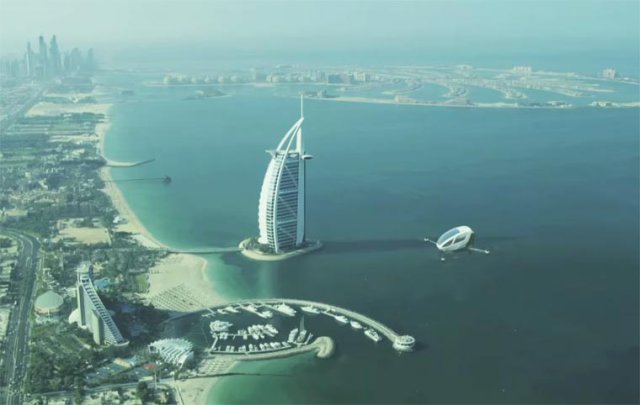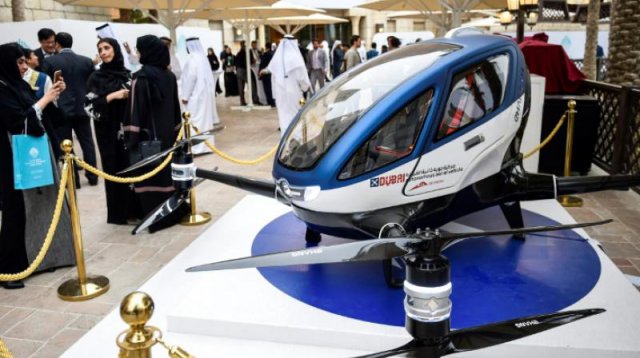
Dubai has tested an autonomous aerial vehicle (AAV) capable of carrying a human in collaboration with the Chinese Ehang Company, said the emirate’s transport authority, aiming to start the operation of the self-driving hover-taxi by July.
The Ehang 184 is fitted with a touchscreen to the front of the passenger seat displaying a map of all destinations in the form of dots, explained the Road and Transport Authority (RTA).
The vehicle has preset routes and the rider is to select the intended destination. It will then start automatic operation, take off and cruise to the set destination before descending and landing in a specific spot. A ground control centre will monitor and control the entire operation.

A model of the EHang 184 at the World Government Summit 2017 in Dubai’s Madinat Jumeirah
Mattar Al Tayer, director general and chairman of RTA said: “The trial run of the first AAV replicates Dubai Self-driving Transport Strategy aimed at transforming 25 per cent of total individual trips in Dubai into Self-driving trips using various modes of transport by 2030. The step would also enhance the integration between public transport modes and people happiness through the provision of smooth, quick and innovative mobility.”
“The AAV exhibited at the World Government Summit is not just a model; it is a real version that we have already experimented the vehicle in a flight in Dubai sky. The RTA is making every effort to start the operation of the AAV in July 2017,” added Al Tayer.
“We have addressed the highest levels of security in the designing and manufacturing of the Ehang184. The vehicle is fitted with eight main propellers, where each propeller would operate at a time, and the systems are separated from the contents of the vehicle.”
“In case of any failure in the first propeller, there would be seven other propellers ready to complete the flight and a smooth landing, while mitigating the impact of the fault sustained by the first propeller. The AAV is fitted with numerous basic systems all in operation at the same time, though independently. In case of any malfunctioning in one of these systems, the standby system would be capable of controlling and safely steering the AAV to the programmed landing point,” explained Al Tayer.
“The AAV is designed to fly for maximum 30 minutes at a maximum cruising speed of 160 km per hour (km/h), and the standard speed shall be 100 km/h. The ascending/descending speed is about 6 meters per second and the landing speed is 4 metres per second (m/s). The AAV measures 3.9 m in length, 4.02 m in width and 1.60 m in height. It weighs about 250 kg and 360 with a passenger,” he added.
“The maximum cruising height is 3,000 feet and the battery charging time is 1-2 hours. The AAV is designed to operate under all climatic conditions unless there is a thunderstorm. The vehicle is fitted with highly accurate sensors with a very low-error threshold and can resist vibrations and extreme temperatures.
“Dubai Civil Aviation Authority was a partner in our trials defining the safety criteria required, issuing the permits for trial and inspecting the vehicle, RTA appreciates their contribution. Etisalat had contributed as well to the success of the test run of the AAV in its capacity as a prime network provider. The 4G data network is used in communication between the AAV and the ground control centre. The Company had also provided the support needed to ensure the continued communication between the AAV and the Control Centre through M2M and LTE technologies,” explained Al Tayer.
He noted that the successful operation of AAV is considered a big step towards innovative and smart mobility solutions for reducing city traffic congestions.
Source: Trade Arabia
